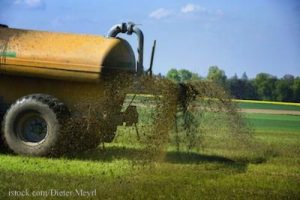The safety of raw manure under the Food Safety Modernization Act (FSMA) final rule on produce safety is being questioned by the FDA. Submissions on assessing the risk of raw manure as fertilizer are requested.
 Manure from cattle, chickens, horses, and other farm animals can be, and usually are, contaminated with E. coli and Salmonella bacteria. The FDA is going to conduct a risk assessment to find out how much consumer health is put at risk by the use of raw manure as fertilizer in growing crops covered FSMA’s produce safety rule. The agency wants helps of stakeholders, the animal agriculture industry, academia, and members of the public.
Manure from cattle, chickens, horses, and other farm animals can be, and usually are, contaminated with E. coli and Salmonella bacteria. The FDA is going to conduct a risk assessment to find out how much consumer health is put at risk by the use of raw manure as fertilizer in growing crops covered FSMA’s produce safety rule. The agency wants helps of stakeholders, the animal agriculture industry, academia, and members of the public.
Produce is the most common food source linked with food poisoning outbreaks. Recent outbreaks just in the past few weeks linked to raw produce include the Salmonella Poona outbreak linked to imported cucumbers, a Salmonella outbreak linked to pistachios, an E. coli outbreak linked to Jack and the Green Sprouts raw alfalfa sprouts, and a Salmonella outbreak linked to Sweetwater Farms raw sprouts.
Raw manure used on crops is a food safety issue. Pathogens that live in animals’ intestines can easily be transferred to produce growing in the field via raw manure. E. coli O157:H7 lives in the intestines of cattle. Salmonella lives in the intestines of poultry. Biological soil amendments of animal origin (BSAs) have been identified as a potentially significant source of pathogens as discussed in a 2015 FDA report.
Growers use raw manure because it is an effective way to replenish nitrogen another nutrients in the soil. It is available at a lower cost than other types of fertilizer, or no cost to farmers who grow produce and dairy products, or it may be shared between neighboring farms.
In the first proposed Produce Safety Rule, the FDA recommended a nine-month interval between applying raw manure and harvest. Many growers, especially organic growers, objected, stating limitations of data on the practices, and the differences between this interval and that recommended by the USDA National Organic Program standards. Those standards call for a 120-day interval between application of raw manure for crops in contact with the soil, and 90 days for crops that do not come into contact with the soil.
FDA is looking for data on prevalence and levels of pathogens in both raw manure from different animals and soil amended with raw manure. They also want to obtain data on the survival of pathogens and their transfer to produce from soil amended with raw manure. In addition, they want data regarding on-farm practices and conditions associated with the growth and production of produce using raw manure, and harvesting practices.
There are restrictions on how raw manure is applied. Farms should not apply manure in a manner that contacts produce covered by the rule during application, and these farms must minimize potential for contact after application.
This risk assessment evaluates and will try to quantify the risk of human illness associated with consumption of produce grown in fields amended with raw manure. The FDA has provided for certain ways that raw manure can be used as a soil amendment in compliance with the produce rule.




